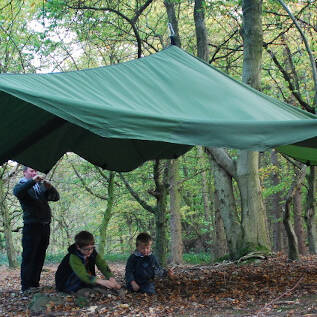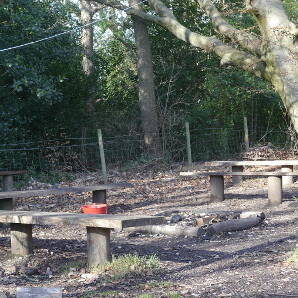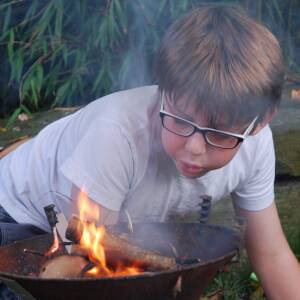Using a shelter above a fire
Points to consider before placing a shelter above an outdoor fire area.

Introduction
It is possible to raise a shelter above a fire but it must be done with serious thought to minimise risk.
The following information provides points to consider whilst carrying out your own risk assessment as to whether a tarp/shelter above a fire in your area is appropriate.
What you'll need
This activity has been provided by

Useful items from our shop
Environmental Considerations
Consider the environmental impact of preparing, carrying out & completing this activity. Could this impact be reduced? Specific considerations for this activity could include:
- risk to nearby flora and fauna
- safe extinguishing of fire after use
Health & Safety Considerations
Follow your usual operating procedures and carry out appropriate risk benefit assessments.
Some considerations particular to this activity include:
- fire risk
- safe & secure use of ropes and fixings
Some key points to consider
Please note, this list is not exhaustive; there may be other things to consider and issues specific to your site and the people you work with. Please use it in conjunction with your own risk assessment & decision making processes.
1. The People
It is crucial to set up safety guidelines and ensure your group adheres to them to help prevent accidents and ensure the safety of all individuals involved. Ideally the group will lead this process and self regulate.
Discus Who & How the following tasks are undertaken:
- Igniting and extinguishing the fire
- Adding fuel to the fire (especially what fuel and how much )
- Moving around and near the fire
2. The Material
If you use a flammable material above a fire and it ignites, spread of fire can happen quickly and there is an additional hazard of burning plastic dripping onto people. Therefore, ideally use fire-resistant or fire-retardant materials or thick heavy-duty hard-to-ignite canvas.
Please note
Fire-retardant materials are designed to burn slowly and self-extinguish, preventing the spread of flames; this does not mean they cannot catch fire.
3. The Height
Deciding on the height of the shelter above the fire - this will depend on the size of the fire but for a small controlled cooking fire consider allowing at least 3m above the heat to allow for ventilation and heat dissipation. Noxious gases can be captured in an enclosed canopy; it is important that your height allows for good ventilation. Therefore, the higher the shelter is above the fire, the better.
If your fires are too hot or too close to any materials, they will damage the integrity and reduce the longevity of your shelter. Consider also the position and placement of ropes and fixings to both avoid trip hazards and ensure they are are not damaged by heat or fire.
4. The Fire
Ensure the area around the fire is clear of flammable materials and trip hazards to prevent ignition and ensure safety whilst moving around the fire.
Fires need to remain small and controlled.
The type of wood used can affect the number of sparks or floating embers. Ideally use dry hardwoods like oak or ash. Resinous woods such as pine should be avoided.
Always supervise the fire to ensure it's not loaded too much, creating a much bigger fire than intended.
Conclusion
By setting up and adhering to your guidelines, you can safely use a shelter above a fire, keeping the rain off while you both enjoy your campfire experience and minimise the risk of fire hazards.
Disclaimer: Muddy Faces cannot take any responsibility for accidents or damage that occurs as a result of following this activity.You are responsible for making sure the activity is conducted safely.
Key Features
- Age Range Adult
- Duration Less than an hour
- Location Anywhere
- Season Any
-
Categories:
Fire, Shelters & Bushcraft
fire
shelters



